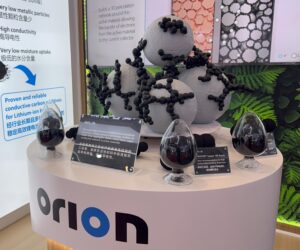Month: May 2025
HOUSTON – Carbon black has been used since ancient times in China and Egypt, yet today it remains a high-tech material worthy of scientific interest. This is due to the numerous ways it can be engineered to serve as an essential component in a variety of everyday products – from paint and textiles to tires, power cables and batteries.

To explore both the fundamentals and the latest innovations, Orion S.A. scientists have authored a new resource: “Carbon Black” in the Encyclopedia of Polymer Science and Technology Online, available via the Wiley Online Library.
The 104-page article is the most current and comprehensive reference about carbon black. It covers the material’s history, morphology and production processes. The paper also presents recent technical findings on sustainability, rubber reinforcement, coloristic properties, electrical conductivity and structure breakdown, among other topics. (For more details, see a summary on Orion’s website here.)
“Many of the products we take for granted would not be possible without carbon black – one of the most ubiquitous materials in modern life,” said Natalia Scherbakoff, chief technology officer at Orion. “We continue to discover new ways to use carbon black to improve the products we rely upon every day.”
The article’s authors include:
- Werner Niedermeier, vice president of Innovation, Polymer Systems
- Ricardo Chavez, innovation manager for Thermoplastics
- Hauke Westenberg, innovation manager for Rubber
- Arndt-Peter Schinkel, vice president Innovation, head of Modelling
Scientists at Orion S.A. have published “Carbon Black” in the Encyclopedia of Polymer Science and Technology Online. The article is the most comprehensive and updated source of information about the material that is essential to a wide variety of products we use in our everyday lives.
For those who have a deep technical interest in carbon black, here is a summary of some of the latest findings included in the paper:
Reinforcement of rubber: Besides carbon black’s morphology, namely specific surface area (STSA) and structure (COAN), the surface energy or surface activity is recognized as a third important parameter, which plays a dominate role in the reinforcement of a rubber matrix. All tests so far indicate that the high-energy centers on the carbon black surface originate mainly from defects and edges of the basal planes and unorganized carbon atoms.

Coloristic properties: Carbon black dispersed in media — for example in plastics — imparts not only a certain blackness but also colors ranging from a bluish to a brownish black. This color range is referred to as the undertone or masstone of the black and is strongly correlated to light scattering. Calculations of the scattering intensity by using Mie scattering theory of particles of 50nm and 200nm can explain why the coloristic impression changes from blue to red for full-shade application and a tinting application.
Electrical conductivity: First, it must be mentioned that all carbon blacks are conductive due to their graphitic nature. The electrical conductivity imparted by carbon black is used in various applications — for example, for lithium-ion batteries, high-volage cables and fuel hoses. This article explains what is meant by an ultra-conductive carbon black and explains the impact of carbon black concentration, specific surface area, structure and dispersion on the conductivity in an application. The electrical conductivity of a carbon black filled compound depends strongly on the gap size between adjacent aggregates, meaning that direct contact between the aggregates is not necessary for establishing a conductive network.
Structure breakdown: It could be shown that an aggregate breakdown can be analyzed by applying aggregate-size distribution (ASD) measurements before and after exposing the carbon black to high pressures. A structure breakdown cannot be observed for standard ASTM grades such as N220 or N134. The breakdown of aggregates tends to occur in large aggregates. Hence, the probability of aggregate breakdown is higher for carbon black with a high OAN (> 150).
Sustainability: It was demonstrated by Orion that virgin furnace blacks can be produced using renewable plant-based-oil, tire pyrolysis oils and bio-circular feedstocks.
By Dr. Michael Rohde
I recently read an excellent study by Dr. Florian Degen and Dr. Oliver Krätzig from the Fraunhofer Research Institution for Battery Cell Production.
The article in the Journal of Power Sources Advances highlights the critical pain points in lithium‑ion battery cell production — from elevated scrap rates and throughput bottlenecks to soaring energy demands. Notably, the mixing & coating step stands out as a key contributor to process inefficiencies and reject rates.

This finding aligns perfectly with our experience at Orion S.A. The underlying challenge often boils down to the “magic triangle” of slurry formulation: dispersion, process conditions and carbon black properties. These pillars are inseparable and must be harmonized to deliver stable, homogeneous slurries and defect‑free electrode coatings.
This finding aligns perfectly with our experience at Orion S.A. The underlying challenge often boils down to the “magic triangle” of slurry formulation: dispersion, process conditions and carbon black properties. These pillars are inseparable and must be harmonized to deliver stable, homogeneous slurries and defect‑free electrode coatings.
Carbon black is often underestimated, largely because it represents only a small mass fraction of the cell. Yet its structure, surface chemistry and aggregate size distribution significantly influence slurry rheology and, in turn, cell performance.
If you’re scaling lithium-ion battery production or working on a new formulation for a project, let’s talk. Orion’s experts in your region are ready to partner with you. They deliver engineered conductive carbon blacks, process tweaks and deep technical insight to accelerate high‑performance electrodes. Contact us!
 Dr. Michael Rohde is the director of Global Marketing for Batteries at Orion S.A. He earned a doctorate in chemistry from the University of Freiburg and an MBA from the Frankfurt School of Finance and Management.
Dr. Michael Rohde is the director of Global Marketing for Batteries at Orion S.A. He earned a doctorate in chemistry from the University of Freiburg and an MBA from the Frankfurt School of Finance and Management.






